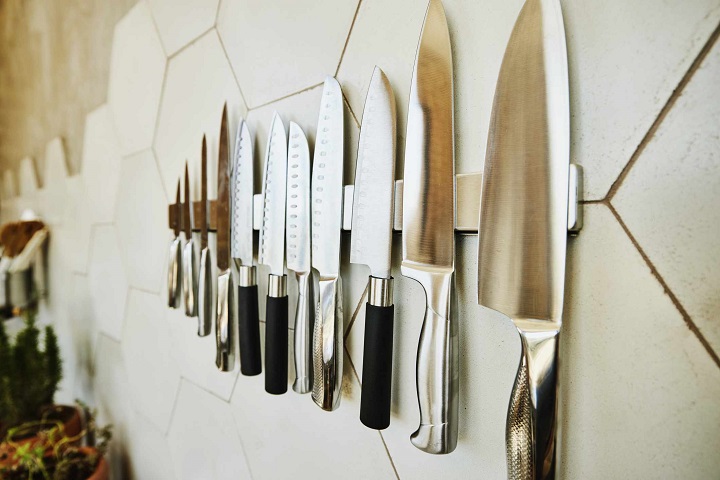Japanese knives, celebrated for their exceptional craftsmanship, excel in precision tasks like slicing and chopping due to their remarkable sharpness. Their superior quality steel and unique designs enhance the overall kitchen experience. However, keeping Japanese blades sharp is crucial for maintaining their performance and longevity. Crafted with high-carbon steel, these knives are more prone to corrosion and damage. So, to preserve their excellence and ensure safety during food preparation, you need to provide proper care, keeping them in top condition for years to come.
Regular Honing

Japanese knives, known for their sharpness and precision, require special attention to maintain their cutting performance. The thin and delicate edges of these knives can be susceptible to minor misalignments during regular use. This is where honing comes into play. Regular honing is a crucial practice for maintaining the blades of your Japanese knife collection, ensuring they stay razor-sharp and ready for precision cutting.
Unlike sharpening, which involves material removal to forge a new edge, honing takes a gentler approach, focusing on straightening and upkeeping the existing edge. This method not only preserves the sharpness of the blade but also corrects microscopic bends that inevitably arise during regular use. To do this, you’ll need a reliable knife honing rod as an essential tool for keeping your knives straight and true in between sharpening.
Being such a crucial tool, it makes for the perfect gift for that friend who loves to cook. When it comes to honing Japanese double-bevel knives, a ceramic sharpening rod proves to be the optimal choice. Ceramic honing rods are harder than traditional steel rods, making them more effective at realigning the blade without removing too much material. The fine-grit surface of a ceramic rod gently hones the edge, leaving it exceptionally sharp without the risk of excessive abrasion.
To keep your Japanese blades sharp, make it a habit to use a ceramic knife honing rod before each use or as needed. Hold the knife at a 15-degree angle to the rod and gently slide the blade along the rod, starting from the base to the tip. Repeat this process several times on each side of the blade to achieve even honing across the entire edge.
By incorporating regular honing with a ceramic sharpening rod into your knife maintenance routine, you not only extend the lifespan of your Japanese knives but also ensure that they consistently deliver the precision and sharpness for which they are renowned. Invest a few minutes in honing, and your Japanese knife collection will remain a reliable companion in the kitchen for years to come.
Soft Cutting Surface

When handling Japanese knives, the choice of a soft-cutting surface is key. With that in mind, opt for wooden or bamboo cutting boards to preserve the blade’s sharpness and integrity. These softer materials absorb impact, reducing stress on the blade and minimising the risk of quick dulling. Unlike hard surfaces, such as glass or granite, soft cutting boards protect the finely honed edge from unnecessary wear.
Cleaning Techniques

Caring for your Japanese knife collection also includes employing proper cleaning techniques which are essential for their longevity. Make sure to wash them with mild soap and warm water immediately after use, avoiding harsh detergents and dishwashers. Gently scrub the blade and handle, taking care not to expose the knife to excessive moisture.
Dry thoroughly with a clean, dry towel, paying attention to the blade-handle junction to prevent rust. Air drying is also effective, ensuring all moisture is gone before storing. This meticulous washing and drying routine protects the blade against corrosion and maintains its sharpness, contributing to the reliability of your Japanese knife collection.
Proper Storage

This is vital for Japanese knives to maintain their sharpness and structural integrity. Storing them in a dedicated knife block, on a magnetic strip, or in blade guards protects the delicate edges from nicks and scratches. You should also avoid tossing them into drawers with other utensils, as friction and contact with hard surfaces can compromise the blade. If you need to transport your knife or store it in a drawer, consider using blade guards. These protective covers shield the edge from potential damage, ensuring your Japanese knives remain in peak condition, ready for precision cuts whenever you reach for them.
Avoid Cutting Certain Foods

To maintain the longevity and sharpness of your Japanese knives, steer clear of cutting through hard bones, frozen foods, and acidic items. These finely crafted blades are susceptible to damage when used on hard bones and frozen materials, risking chipping or premature dulling. Additionally, acidic foods like tomatoes or citrus can accelerate corrosion and compromise the blade’s integrity. That being said, remember to use a separate tool for bone-related tasks, frozen items, and acidic foods to protect your knife’s delicate edge.
Oil Carbon Steel Blades

Oiling your carbon steel blades is essential for maintaining sharpness and preventing rust. Opt for a food-safe mineral oil, as it creates a protective barrier against moisture and oxidation. To oil, first clean the blade thoroughly and make sure it’s completely dry. Apply a thin layer of mineral oil using a soft cloth, focusing on the blade’s surface. This prevents rust formation and enhances the knife’s resilience. Regular oiling, especially after exposure to acidic foods, further safeguards the blade. This simple maintenance ritual not only preserves the sharp edge but also prolongs the life of your carbon steel knife for extended durability and consistent peak performance.
Handle with Care

Using your Japanese knives with care is crucial for preserving their precision and longevity. These knives are delicate, so it’s essential to handle them gently. By employing proper cutting techniques, such as using a rocking or slicing motion, you ensure the blade glides effortlessly, minimising stress on the edge. When using your knives, try to steer clear of twisting, cleaving, or prising with the blade. Instead, go for straight, even strokes. This way, you not only maintain the good condition of your knife but also achieve those flawless cuts you aim for.